Are you yearning for the freshness of homegrown produce straight from your backyard? Or perhaps you’re looking to bolster your self-reliance amidst the unpredictability of our times? Or maybe you’re simply seeking to polish your gardening skills? This article is a perfect fit for you.
We’re about to embark on an exciting journey into the realm of speedy vegetable growth. This not only gives you a head start on the growing season, but it can potentially help you sidestep looming food shortages. Furthermore, homegrown food enables superior quality and nutritional control – after all, we truly are what we consume! And, we’re going beyond mere salad leaves.
This guide will introduce you to the fastest-growing vegetables, from zesty microgreens to crisp, full-sized carrots. For each vegetable, we’ll be serving up all the essential details – optimal planting times, harvest duration, and top-notch tips to ensure your crops flourish.
No matter if you’re a gardening newbie or a seasoned gardener, this comprehensive guide will serve as your go-to resource for fast harvest, nutrient-rich veggies. Ready to immerse yourself in the soil? Let’s delve into the world of speedily harvesting fresh produce!

Fast Growing Vegetables To Plant In Your Garden
| Vegetable | Time to Harvest | Ideal Growing Seasons | Other Important Info |
|---|---|---|---|
| Microgreens | 7-14 days | Year-round | Quick to grow, ideal for indoor and outdoor gardening |
| Green Onions | 20 days | Late fall or early winter | Can be grown indoors in early spring |
| Salad Leaves | 21 days | Spring or fall | Rich in dietary fiber and low in calories |
| Radishes | 25 days | Late winter and early spring | Can be grown multiple times during the year |
| Arugula | 30 days | Early spring or fall | High in vitamin K and A |
| Baby Carrots | 30 days | Spring or fall | Multiple crops can be planted within a year |
| Bok Choy | 30 days | Spring or late summer | Retains crisp texture even after cooking |
| Spinach | 30 days | Spring (most climates) | Offers alpha-linolenic acid and lutein and zeaxanthin |
| Green Beans | 40 days | Spring (after last frost) | Naturally infuses surrounding soil with nitrogen |
| Carrots | 50 days | Spring or fall | Excellent source of biotin and vitamin A |
| Cucumber | 50 days | Spring or summer | High water content, rich in potassium and calcium |
| Beets | 50 days | Spring or late summer | Beet leaves can be harvested separately around 30 days |
| Kale | 55 days | Spring or fall | Offers alpha-linolenic acid and lutein and zeaxanthin |
| Broccoli | 60 days | Late winter or early spring | Full fall crop possible in warmer climates |
| Peas | 60 days | Early spring | Rich in vitamins A, C, K, and thiamine |
| Turnips | 60 days | Spring or fall | Turnip greens are nutrient-dense and an excellent substitute |
Growing your own vegetables can be an exciting venture. Not only does this hobby offer fresh, nutritious produce right at your fingertips, but it’s also a rewarding way to connect with nature. Fast-growing vegetables are particularly appealing for beginner and seasoned gardeners alike, as they offer a quick turnaround from planting to harvest. This article explores a variety of such vegetables, each boasting a unique nutritional profile, and shares essential tips for successful cultivation.
However, before plunging into the world of vegetable gardening, a few factors require consideration:
- The growth times mentioned herein are approximations assuming optimal conditions, including nutrient-rich soil, good drainage, and generous sunlight exposure.
- Always wash your freshly harvested vegetables before consumption, especially if you’ve used fertilizers.
- Nutrient content can vary between vegetable varieties and some nutrients may reduce during cooking. Factor this in when planning meals to meet specific dietary requirements.
Now, let’s delve into the world of fast-growing veggies:
Microgreens
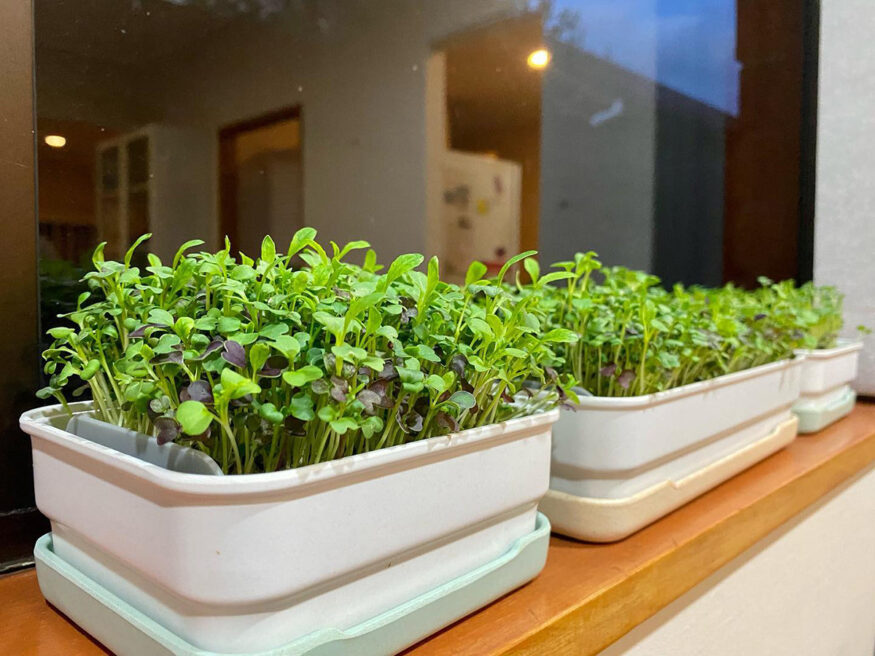 Source: micropodnz on Instagram
Source: micropodnz on InstagramTime To Harvest: 7-14 days
Ideal Growing Season: Year-round
When To Grow and Length of Growing Period
“Microgreens” is a term you’ll hear often if you’re exploring the world of home gardening. These are essentially young salad plants like celery, rocket, kale and much more, that grow fast and are harvested when they’re just 1-2 inches tall.
What makes them so appealing? They are easy to plant, quick to grow, they can be cultivated round the year, and they pack a nutritional punch!
Diverse Varieties of Microgreens
Several popular microgreens come from a range of plant families:
- Brassicaceae family: This includes cauliflower, broccoli, cabbage, watercress, radish, and arugula.
- Asteraceae family: Lettuce, endive, chicory, and radicchio are a few examples.
- Apiaceae family: Dill, carrot, fennel, and celery fall into this group.
- Amaryllidaceae family: This encompasses garlic, onion, and leek.
- Amaranthaceae family: Amaranth, quinoa swiss chard, beet, and spinach are part of this family.
- Cucurbitaceae family: This family constitutes melon, cucumber, and squash.
Microgreens can be grown in special containers, making them ideal for both indoor and outdoor gardening. With the right seeds and optimal soil conditions, you can enjoy a year-round harvest of these fast-growing veggies.
Edible and Nutritional Uses For These Vegetables
Each microgreen variety offers a unique flavor, ranging from neutral to spicy, bitter, or even sour. But what’s truly impressive is their nutritional value. These tiny leaves are loaded with concentrated levels of vitamins, antioxidants, and minerals, making them a super addition to your everyday meals.
Green Onions
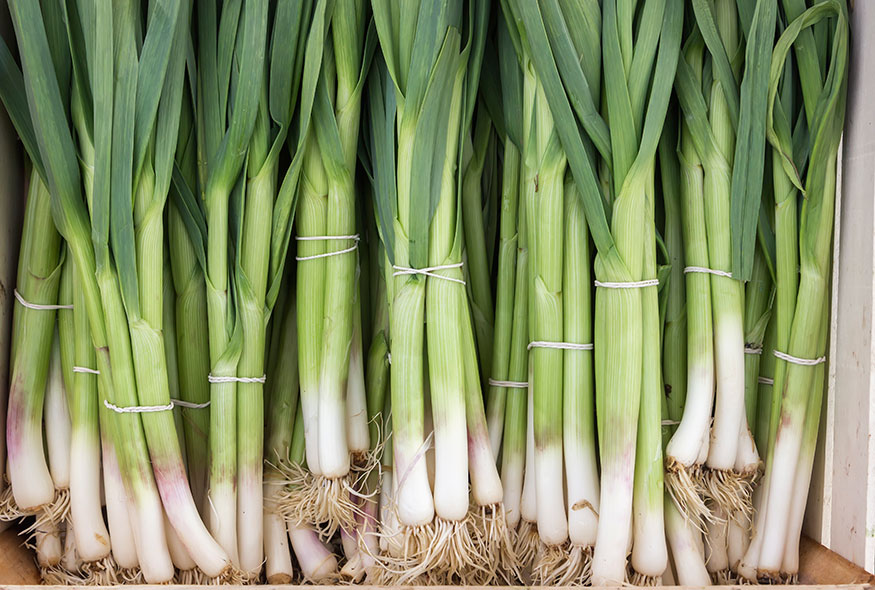
Time To Harvest: 20 days
Ideal Growing Season: Late fall or early winter (outdoor), early spring (indoor)
Where To Buy Seeds: Available at Amazon
Belonging to the close-knit family of various vegetables such as the classic onion, shallot, chive, and leek, green onions (commonly known as scallions or spring onions) are a fast-growing vegetable ideal for your home garden.
Growing Season and Length of Growing Period
When it comes to growing green onions outdoors, the late fall or early winter season provides the perfect ground temperature for the bulb to take root. As the winter passes, these fast-growing veggies begin to sprout with the warmth of spring. However, if you prefer indoor gardening or have access to a climate-controlled environment, early spring is the optimal soil temperature time to plant these to kickstart their growth.
From the point of planting, you can expect this vegetable to be ready for harvest within 20 days. Growing green onions from a set is a tried-and-true method for achieving this short growing period.
Edible and Nutritional Uses For This Vegetable
As versatile as they are speedy to grow, green onions play more than just a supporting role in your recipes. While not typically consumed alone, the whites and greens of this vegetable offer different flavors and uses. Cook the whites to unlock a robust onion flavor that can uplift any dish, while the greens can add a fresh crunch to salads, soups, fried rice, or an egg salad sandwich.
Despite being primarily water, green onions pack a nutritional punch. They are heart-healthy with minimal calories, fat, and cholesterol. Better yet, one serving provides almost double the daily recommended dose of Vitamin K. If you’re pregnant and in need of folates, green onions are a healthy addition to your diet. These vegetables are less dense than other folate-rich options, making them an easy, nutritious post-cooking addition to any meal.
Salad Leaves / Lettuce
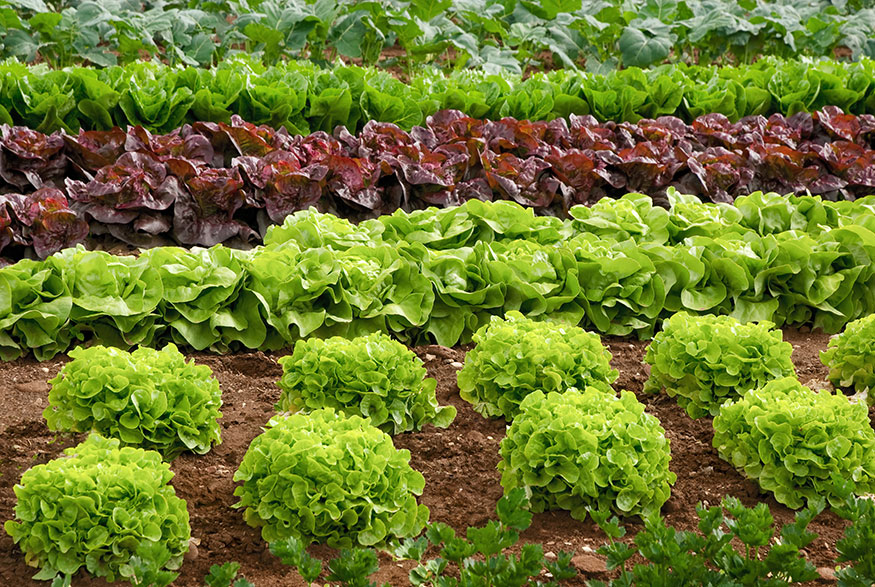
Time To Harvest: 21 days
Ideal Growing Season: Spring or fall
Where To Buy Seeds: Available at Amazon
Growing Season and Length of Growing Period
Belonging to a broad family of leafy green vegetables, salad greens flourish best in cooler weather. Yet, they do not favor extremely high temperatures, above 80 degrees, or low ones, below 50 degrees, as these conditions can impede their germination.
Hence, planting your salad greens a few weeks before the temperate part of your area’s spring season is optimal. With the right conditions and sun exposure, these fast-growing greens can mature in a short span of just 21 days.
Edible and Nutritional Uses
Salad greens, as their name implies, are perfect for fresh, raw consumption. Toss them in with cherry tomatoes and red onions to create a vibrant, flavor-packed salad. They are an excellent substitute for store-bought iceberg lettuce, instantly sprucing up homemade tacos and sandwiches.
Moreover, homegrown salad greens retain high dietary fiber content, surpassing their store-bought counterparts. This plant is also low in calories, allowing you to indulge in these greens without straying from your dietary goals. Regular consumption of these nutrient-rich greens can be a beneficial addition to your diet.
Radishes

Time To Harvest: 25 days
Ideal Growing Season: Late winter and early spring
Where To Buy Seeds: Available at Amazon
Growing Season and Length of Growing Period
Do you often wonder what to grow during the transition from winter to spring? Well, radishes are your answer. This versatile vegetable can be planted as early as late winter using a simple warming enclosure, allowing you to kickstart your gardening season.
You’ll love the speed at which radishes grow – just 25 days from seed to harvest! You’re not restricted to a single harvest either; the quick-growing nature of radishes means you can plant several crops throughout the season, extending your harvest well into summer.
Meanwhile, certain hardy varieties of radishes can be planted in midsummer and nurtured till winter, giving you fresh produce in the colder months. Their longer growing period makes them a garden staple across seasons!
Edible and Nutritional Uses
When it comes to consumption, radishes are a flexible vegetable. Enjoy them raw and crisp, quartered as a crunchy side or thinly sliced for a burst of flavor in your summer salad. Want to try something different? Pickle them! This process infuses the radishes with a variety of flavors and extends their shelf-life, allowing you to enjoy this zesty vegetable even in its off-season.
Did you know radishes can be cooked too? They make a delicious accompaniment to grilled meats when skewered or can be roasted in a crockpot with a juicy cut of pork or beef, offering a fast and tasty addition to your meals. The cooking process softens the radish, making it more palatable for those who find its raw flavor a little too punchy.
Beyond their versatility in the kitchen, radishes pack a nutritional punch: abundant in vitamin C and a great source of fiber. They even contain glucosinolates, compounds that some studies suggest have cancer-preventing properties.
Arugula

Time To Harvest: 30 days
Ideal Season To Grow: Early spring or fall
Where To Buy Seeds: Available at Amazon
Growing Season and Length of Growing Period
If you’re looking to add a leafy vegetable to your garden, arugula is a great choice. Best planted in early spring when the sun is generous, it boasts large, richly colored leaves and a fast growth rate – a full head of arugula can be ready for harvest in just 30 days!
Worried about missing the spring sowing season? No problem. Arugula is a flexible crop that can be planted again in fall, guaranteeing a fresh harvest before the frost sets in. While the fall yield may be slightly smaller, it provides a wonderful opportunity to keep your garden productive across the seasons.
Edible and Nutritional Uses
Arugula’s unique, slightly spicy flavor makes it a versatile addition to any dish. Substitute it for spinach in any recipe, or toss it raw into a salad for a peppery twist. When wilted, arugula imparts its unique flavor to meats or pasta sauces, making it an essential ingredient in your culinary palette.
Nutritionally, arugula is a hidden gem. With just 5 calories per serving and virtually no fat, it’s a guilt-free addition to any meal. Rich in vitamin K and A, it’s a nutritional powerhouse, supporting everything from your skin health to your immune system.
Baby Carrots
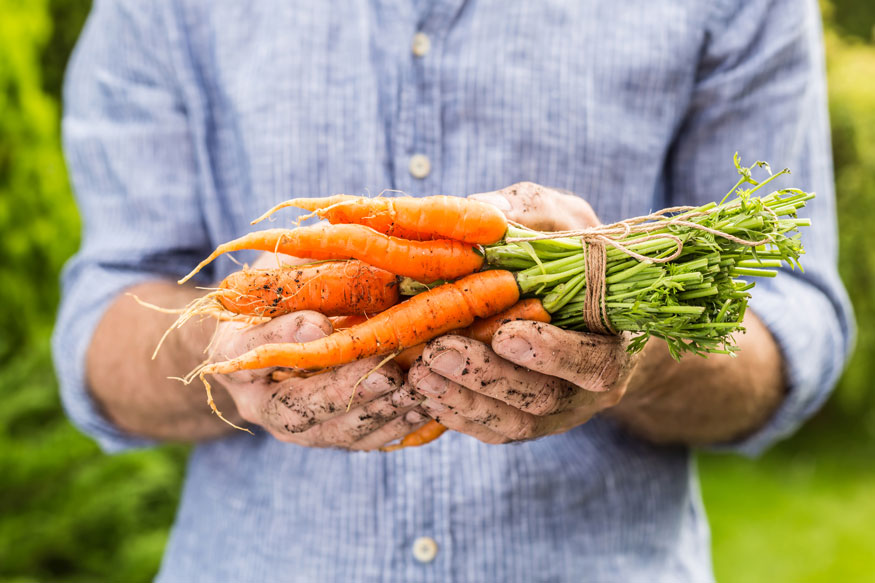
Time To Harvest: 30 days
Ideal Season To Grow: Spring or fall
Where To Buy Seeds: Available at Amazon
Growing Season and Length of Growing Period
If you’re looking for vegetables that produce a quick yield and allows for multiple crops within a year, baby carrots are a great option.
Their short growth period of around 30 days enables you to sow their seeds more than once during the spring or fall seasons. A second crop in the fall is particularly feasible since carrots are quite frost-resistant.
Edible and Nutritional Uses
Garden-fresh baby carrots are a true delight. Typically enjoyed raw after a thorough rinse, they also add a flavorful crunch to stir-fries and soups. Their size is perfect for pickling in large quantities.
Nutritionally, baby carrots are packed with beneficial nutrients. They are rich in alpha and beta-carotene, essential for promoting eye health. Plus, they contain antioxidants like lutein and lycopene, further enhancing their value for eye health.
Bok Choy
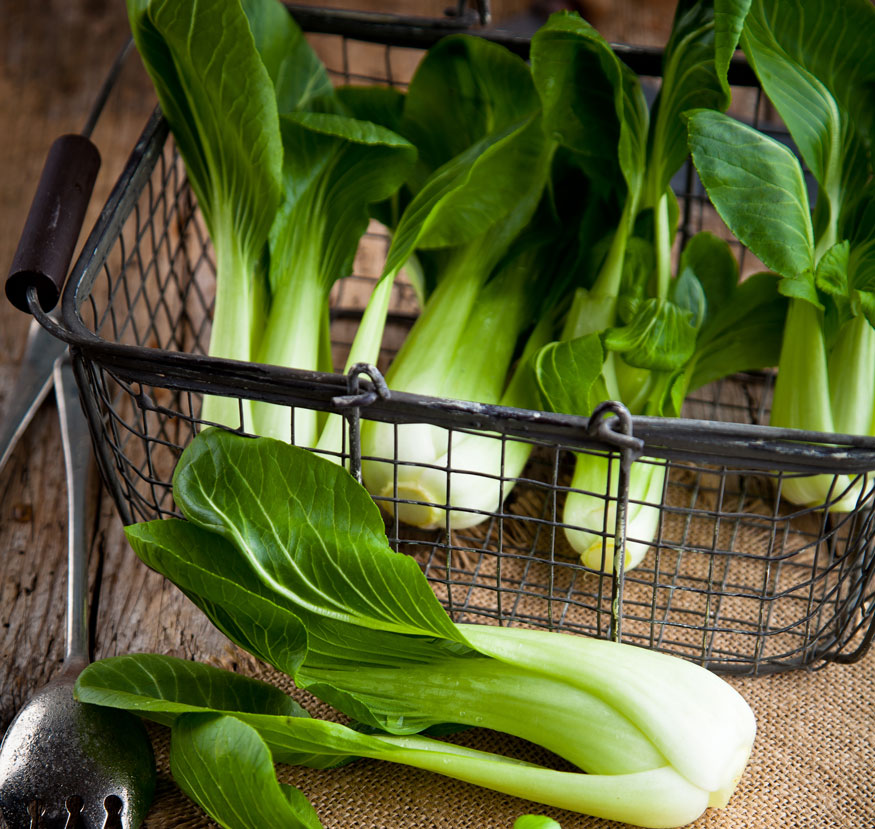
Time To Harvest: 30 days
Ideal Growing Season: Spring or late summer
Where To Buy Seeds: Available at Amazon
Growing Season and Length of Growing Period
Bok choy, a popular Asian vegetable, thrives in climates that allow for multiple crops each year. In other regions, you can plant bok choy in spring and late summer, with optimal conditions leading to maturity within 30 days.
Baby bok choy, a smaller variant, may have an even shorter growth period.
Edible and Nutritional Uses
Bok choy is known for retaining its crisp texture even after cooking. It’s a staple in various stir-fries and can also be sautéed or braised, similar to cabbage. Despite its size, bok choy is low in calories and fat but contains a decent amount of protein.
It’s also packed with key nutrients like calcium, phosphorus, potassium, and vitamins C, A, and K.
Learn more: 14 Fast Growing Flowers That Bloom Quickly
Spinach
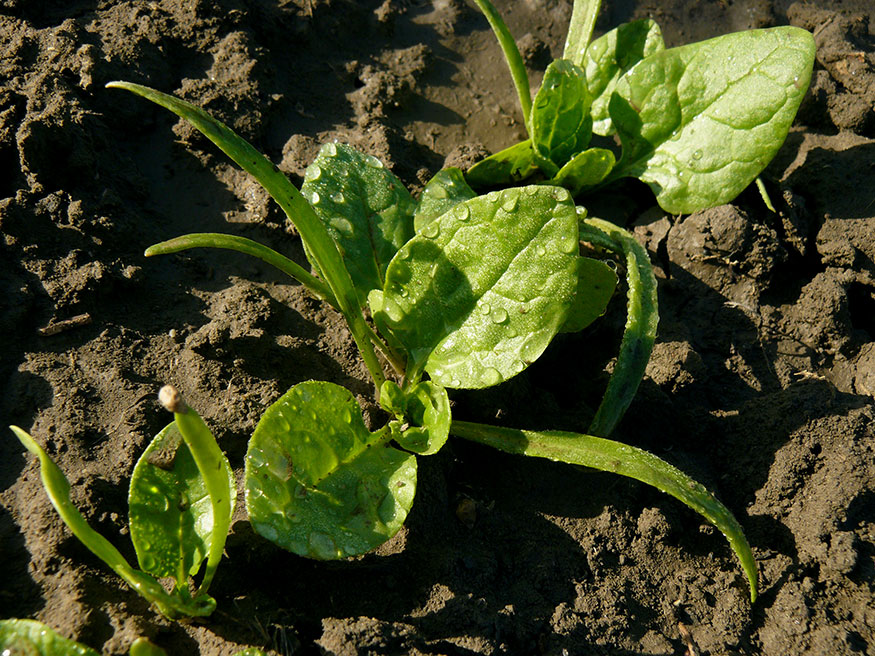
Time To Harvest: 30 days
Ideal Season To Grow: Spring (most climates), fall (mild winter climates)
Where To Buy Seeds: Available at Amazon
Growing Season and Length of Growing Period
Spinach is a garden favorite, easily cultivated at home. Plant alongside other vegetables in the spring and, providing the weather stays cool, you’ll have mature spinach plants in about 30 days.
More flexible than you might think, spinach can also grow in a cold frame for an early spring harvest, or in mild winter climates for a winter yield.
Edible and Nutritional Uses
Contrary to Popeye’s preference, fresh spinach, not canned, is a culinary stand-out. Combine it with iceberg lettuce for a refreshing salad, or wilt it into various dishes. Spinach pairs particularly well with cheese-based meals.
Nutritionally, spinach is a powerhouse, offering ample iron crucial for hemoglobin production and a high amount of carotenoids easily converted into vitamin A by our bodies.
Green Beans

Time To Harvest: 40 days
Ideal Season To Grow: Spring (after last frost)
Where To Buy Seeds: Available at Amazon
Growing Season and Length of Growing Period
Green beans are a home garden classic. They’re easy to cultivate and can typically be planted after the last spring frost. This timing allows the beans to properly germinate and establish roots without the interference of chilling ground temperatures. With sufficient sunlight and hydration, most green bean varieties can start producing pods within 40 days.
Moreover, green beans are excellent for small spaces and enriching the soil. These plants naturally infuse the surrounding soil with nitrogen, which benefits future plants in the same area, making them an excellent choice for crop rotation.
Edible and Nutritional Uses
Green beans are pretty versatile when it comes to culinary usage. Some people enjoy the crunch of raw green beans while others savor their flavorful tang when pickled. Boiling fresh green beans often retains their vibrant color, and roasting them can add a delightful charred taste.
Not just tasty, these vegetables are rich in essential nutrients such as vitamin C, dietary fiber, folate, vitamin K, and silicon, which are beneficial for bone, skin, and hair health. Most of these nutrients are stored in the bean’s pod, so be sure to include it in your dishes to maximize their health benefits.
Carrots
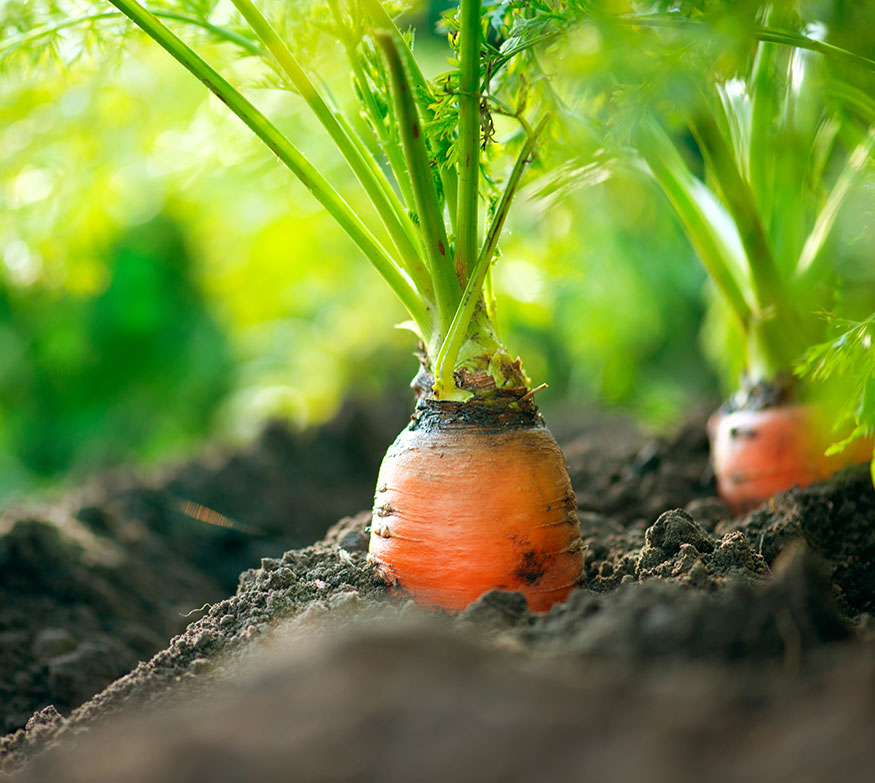
Time To Harvest: 50 days
Ideal Growing Season: Spring or fall
Where To Buy Seeds: Available at Amazon
Growing Season and Length of Growing Period
Unlike their mini counterparts, full-sized carrots can flourish in most fertile soils during their optimal growing seasons in spring and fall in your vegetable garden.
However, they require around 50 days to reach maturity under ideal conditions, which can make fall planting somewhat tricky due to potential deep freezes.
Edible and Nutritional Uses
Carrots are one of the few fast-growing veggies that taste amazing raw. However, they should be consumed quickly as fresh carrots don’t have a long shelf-life. Roasted, pickled, boiled, or baked into a scrumptious carrot cake, there’s a multitude of ways to enjoy these root vegetables.
Besides their delightful taste, carrots are an unbeatable source of biotin, a B vitamin that can boost metabolism and aid weight loss. As with other red and orange vegetables, carrots also offer a hefty dose of vitamin A, beneficial for eye health.
Cucumber

Time To Harvest: 50 days
Ideal Growing Season: Spring or summer
Where To Buy Seeds: Available at Amazon
Growing Season and Length of Growing Period
Cucumbers are a warm-season crop and do not tolerate frost. Therefore, it’s best to plant them when the temperatures start to rise in your region. For warmer climates, this could be as early as late winter, but in most areas, a mid-spring start should work perfectly. With proper watering, cucumbers typically mature around the 50-day mark.
Edible and Nutritional Uses
Cucumbers offer remarkable versatility. They can be enjoyed raw in salads, added to water for a refreshing twist, diced into veggie wraps, or pickled for homemade goodness. You can even use cucumbers to create a fun twist on sushi rolls at home!
Cucumbers are known for their high water content, making them an excellent hydrator. But that’s not all; they also provide a surprising amount of potassium and calcium. A single serving of cucumber even surpasses the daily recommended intake of vitamin K.
Beets
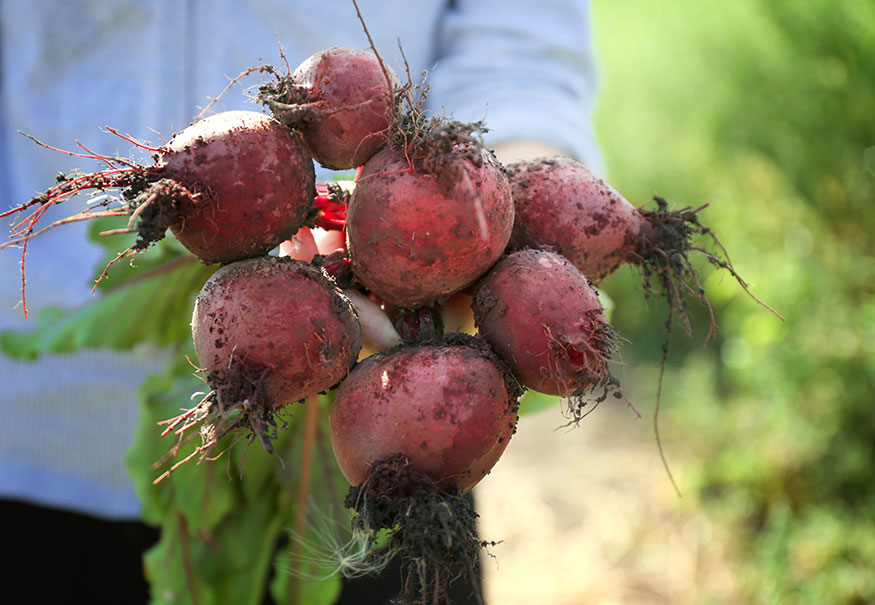
Time To Harvest: 30 days (leaves), 50 days (bulb)
Ideal Growing Season: Spring or late summer
Where To Buy Seeds: Available at Amazon
Growing Season and Length of Growing Period
As the cool-weather wonder crop gaining popularity, beets are finding their way into numerous home gardens. Awaiting a couple weeks post the final spring frost, determined gardeners plant their beet seeds. As the temperature gradually rises, expect your beets to achieve edible maturity around the 50-day mark.
Opting for late summer or early autumn planting? Be prepared for a slight extension in the growing period, due to cooling soil temperatures. But remember, the first autumn frost is a beet’s enemy – harvest before it strikes.
For those considering harvesting beet leaves separately for their unique nutritional offering, bear in mind that it can potentially hamper the main beet’s growth. Typically, beet leaves are plucked around the 30-day mark post germination.
Edible and Nutritional Uses
Famed for their rich crimson juice, beets are versatile, similar to potatoes in terms of preparation. Whether it’s slicing, dicing, roasting, or frying, beets retain their unique mild flavor. Modern trends have seen an increase in pickled beets and beet juice.
With a dense structure similar to potatoes, beets deliver a good amount of fiber per serving. The beet’s modest nutrient load also includes over 15% of your daily manganese intake per serving, making it ideal for those with digestive issues.
Kale
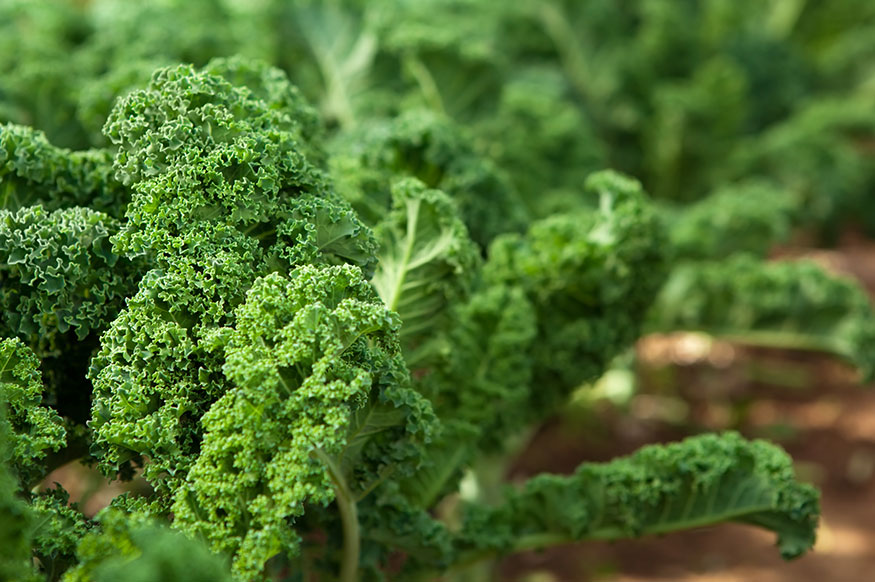
Time To Harvest: 55 days
Ideal Growing Season: Spring or fall
Where To Buy Seeds: Available at Amazon
Growing Season and Length of Growing Period
Kale, the trendy vegetable with a rising price tag, is an ideal candidate for home gardens. Plant your seeds about a month after the last major frost – this could be early or late spring, based on your location. With proper drainage, your kale will be ready for consumption around 55 days later.
Edible and Nutritional Uses
Kale, with its distinct nutty flavor, is a fantastic addition to a range of recipes needing more than what spinach can offer. Whether steamed, incorporated into omelets, casseroles, or salads, it’s a culinary delight.
Raw kale is nutrient-dense, offering alpha-linolenic acid, an omega-3 fatty acid, and lutein and zeaxanthin, which can prevent macular degeneration and cataracts.
Broccoli
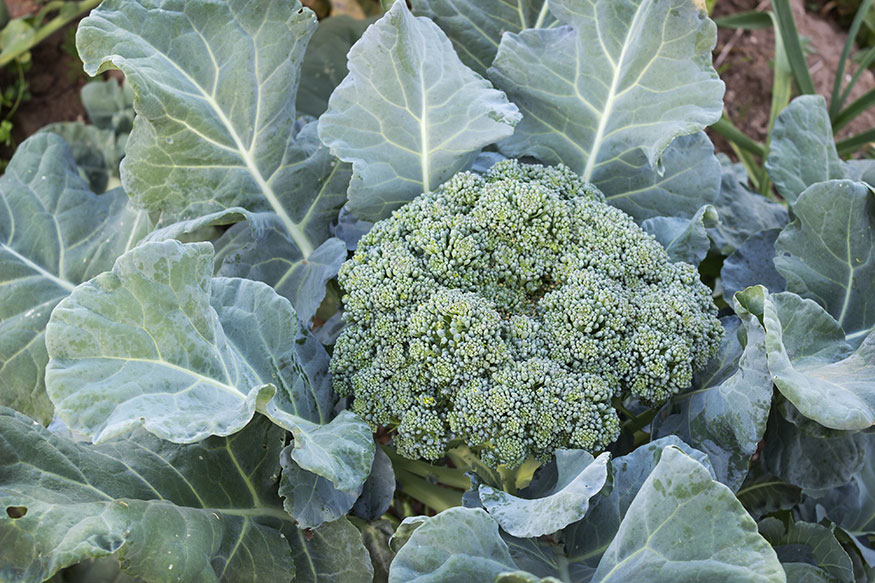
Growing Season of Fast Growing Broccoli
Time To Harvest: 60 days
Ideal Growing Season: Late winter or early spring
Where To Buy Seeds: Available at Amazon
Broccoli is a home-grower’s surprise. Thriving in a cool climate around 75°F, it’s best to plant broccoli in the spring and early summer, with a harvest around 60 days later. Warmer climates may allow for a mid-summer plant and a full fall crop.
Edible and Nutritional Uses
Homegrown broccoli heads, just like store-bought ones, can be enhanced through cooking. Whether it’s steaming, blanching, roasting, or sautéing, you’ll bring out the rich flavors.
Broccoli’s structure retains many of its nutrients, regardless of preparation. One serving can provide an impressive 135% of your daily vitamin C intake – that’s enough to rival orange juice! Plus, it offers 116% of your daily vitamin K intake, securing its place as a superfood.
Peas

Time To Harvest: 60 days
Ideal Growing Season: Early Spring
Where To Buy Seeds: Available at Amazon
Then To Plant Peas
Peas may not be to everyone’s taste, yet cultivating them at home could be an unexpectedly rewarding experience. As one of the first seeds to hit the soil in early spring – when ground temperatures nudge above 45° F – peas are a delight to grow. With just the right balance of water, sunlight, and proper caging, you can expect to see delectable pods developing within 60 days.
Edible and Nutritional Uses
Peas are fascinatingly versatile. Enjoy them crunchy and raw, straight off the vine, or add them to stir fries for a softer bite. They can also be steamed, boiled, or mashed for a delightful side dish. Along with versatility, peas are a nutritional powerhouse.
A simple ½ cup serving provides a hefty dose of vitamins A, C, and K, along with a robust level of thiamine, which aids your body in harnessing energy from other key nutrients in your diet.
Turnips

Time To Harvest: 40 days (leaves), 60 days (bulb)
Ideal Growing Season: Spring or fall
Where To Buy Seeds: Available at Amazon
When To Plant Turnips
Turnips may not be a staple in many diets, but you might be surprised at how their unique flavor can complement your meals. These cool-weather veggies thrive when planted in spring or fall, avoiding the dry heat of summer months.
Once established, turnips can be harvested in about 60 days. For those seeking to use the unique leaves of turnips, a 40-day wait should suffice.
Edible and Nutritional Uses
Turnips can be a mysterious addition to many American kitchens. However, with a little creativity, these root veggies can add a unique twist to soups, sautés, and even as homemade chips. Turnip greens, a nutrient-dense powerhouse, are an excellent substitute for other leafy greens in salads, pasta dishes, and more.
One cup of raw turnip greens provides an impressive 115% of your daily vitamin K intake, with raw turnips contributing 30% of your daily vitamin C intake.
Try The Fastest Growing Vegetables In Your Garden
Fast-growing vegetables, like peas and turnips, can offer a plethora of benefits. Not only can you enjoy the process of cultivating them in your home garden, but you also gain an economical way to boost your daily nutrient intake. So why wait? Get planting and savor the fruits of your labor in no time!